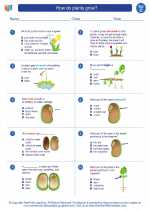How do plants grow? -> structural adaptations
Structural Adaptations
Structural adaptations are physical features of an organism that have evolved over time to help it survive in its environment. These adaptations can include things like body shape, size, and specialized body parts.
Here are some key points to remember about structural adaptations:
- Structural adaptations are physical features that help an organism survive in its environment.
- These adaptations are the result of natural selection, where individuals with the most beneficial traits are more likely to survive and reproduce.
- Structural adaptations can help organisms obtain food, find mates, avoid predators, and withstand harsh environmental conditions.
- Examples of structural adaptations include the long neck of a giraffe for reaching high leaves, the sharp claws of a predator for catching prey, and the thick fur of an arctic fox for staying warm in cold climates.
It's important to understand how structural adaptations help organisms thrive in their environments, and how these adaptations have developed over time through the process of evolution.
Here are some study guide questions to help you review the topic of structural adaptations:
- What are structural adaptations and how do they help organisms?
- Give an example of a structural adaptation and explain how it helps the organism survive.
- How do structural adaptations relate to the process of evolution?
- What role does natural selection play in the development of structural adaptations?
- Think of an animal and identify a structural adaptation that helps it survive in its environment.
By understanding structural adaptations, you can gain insight into the remarkable ways in which organisms have adapted to their environments over time.
.◂Science Worksheets and Study Guides Third Grade. How do plants grow?

 Activity Lesson
Activity Lesson
 Worksheet/Answer key
Worksheet/Answer key
 Worksheet/Answer key
Worksheet/Answer key
 Worksheet/Answer key
Worksheet/Answer key
 Worksheet/Answer key
Worksheet/Answer key
 Vocabulary/Answer key
Vocabulary/Answer key
 Vocabulary/Answer key
Vocabulary/Answer key
